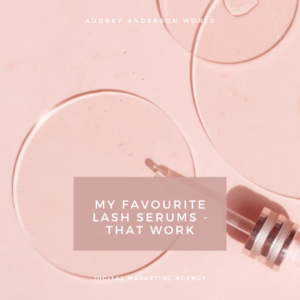
Lash Serums That Work My Favorite – 2023 Review
Lash Serums That Work and are my favourite – A Review We may get paid a commission if you buy something after clicking on one of our affiliate links here
LinkedIn Algorithm


Every social media network updates its algorithms regularly, Facebook Instagram LinkedIn. Today, I’ll show you how to exploit the Social Network algorithms that work (LinkedIn algorithm), as it stands in 2021, to your advantage so that more people see your profile and, more importantly, see and engage with your content.
Audrey Anderson has experience with FMCG Suites, thirty-two years of business experience, and 12 years as a social media marketer. So let’s go over all five of the most important things you should know about the LinkedIn algorithm and LinkedIn marketing strategy.
According to recent social media statistics, in terms of new marketing tools and user growth, LinkedIn is now rising.
This post will discuss how and why LinkedIn should be a part of your marketing plan, how a social media management tool may help you develop your LinkedIn marketing strategy, and how to master the LinkedIn algorithm in 2021.
Then, for each one, I’ll tell you precisely what you should do to take advantage of that portion of the algorithm’s power with your LinkedIn Post (social media posts). And why this should be part of your Social Media Marketing Efforts.
Analyses and tests can help you fine-tune your Personal Brand + LinkedIn marketing strategy.

LinkedIn is the world’s largest professional online networking platform and social networks.
LinkedIn is more than simply a social media platform or social network; it can be utilised to connect with coworkers, friends, family, as well as help advance your career through new contacts, online learning, and other means.
In a nutshell, LinkedIn is much more than a resume website. Here’s a list of some things you can do on LinkedIn that isn’t exhaustive:
A social media algorithm is a computer programme that determines which social media postings appear at the top of your feed and which do not.
Let’s go over how the algorithm handles a LinkedIn post update step by step: LinkedIn is aware that some individuals seek to manipulate the system or reverse-engineer it.
Here are some distinguishing characteristics of this social media algorithm: The following are the most important updates for 2021: Here are some strategies for succeeding against the LinkedIn algorithm. (aside from running paid ads)
When you post an update, a bot automatically categorises it as one: the LinkedIn algorithm has been changed to show members posts from people they truly know to solve the gap.
You obviously want to be in the “clear.” However, if your work is classified as “low-quality,” it may still advance to the next round.
Overall, the amount of engagement that piece of content has received (especially in a short period) and how much you engage with that creator’s work, in general, are significant factors in almost all social media algorithms.
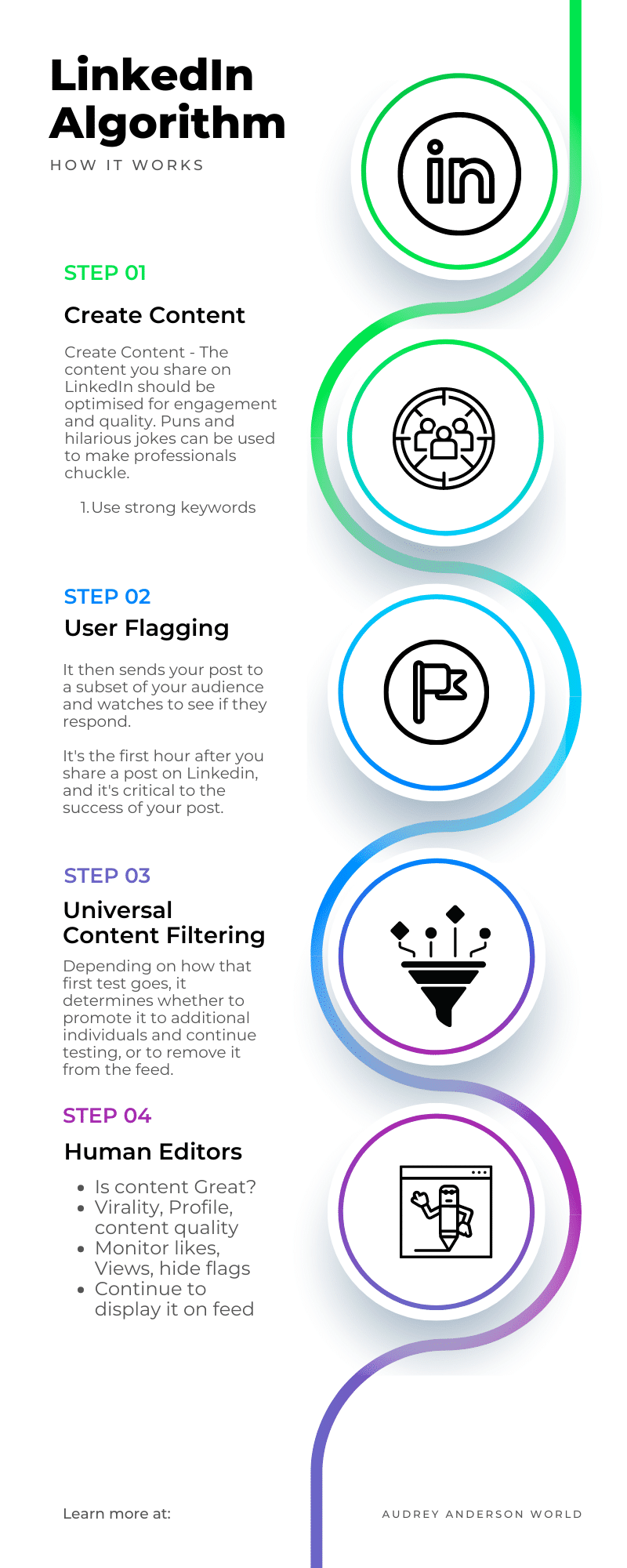
According to Pete Davies, LinkedIn’s senior director of product administration, the company’s tagline is “Folks, talking about what matters to you.”
The LinkedIn algorithm places a high value on personal connections and related content. It also considers information on profiles, such as interests and abilities, and which members work with, among other things.
The LinkedIn algorithm prioritises high-quality relevancy above recency. Its goal is to provide customers content that is of interest to them ahead of more recent entries.
In this manner, LinkedIn can display articles, videos, job postings, and different content that best fit what the customer is looking for – or is more likely to interact with.
LinkedIn is essential for developing and sustaining professional relationships, whether for your personal brand or your business. The primary distinction between articles and posts is that articles are currently indexed by search engines, whereas posts are not.
This takes us to the algorithm’s second goal: to increase consumer participation in your Content Marketing Strategy for your Personal Branding or Business.
Displaying relevant content to clients encourages them to continue using the network, re-sharing content, and investing in LinkedIn advertising. Finally, please don’t overlook the significance of timing when it comes to increasing your engagement rate.
I’m continually astounded by the virality of some LinkedIn posts I’ve seen on the LinkedIn feed.
Regardless of your connection, your postings can reach a much larger audience, even generating thousands of views, likes, and feedback.
How to Succeed in Search Engine Marketing On LinkedIn, you can
LinkedIn employs the factors above to determine how to “filter” customer content and expose it to different consumers. Because it’s not a complicated algorithm, you can understand it right away.
Below, I’ll go over some suggestions for how to use LinkedIn posts to your advantage.
Whereas the search engine marketing world provides us with many valuable tools for undertaking Google keyword analysis, we don’t have nearly as many resources available to us when it comes to LinkedIn.
But don’t worry! When you know where to look, LinkedIn analysis becomes quite simple.
For example, suppose you want to “rank” in LinkedIn for “search engine marketing copywriter,” but aren’t sure if it is the suitable period to employ or how to optimise for it.
A preliminary search for “search engine marketing copywriter” on LinkedIn will yield different results, indicating what terms are being used by various profiles and how.
The audience testing stage has arrived. After bots have classified your post, they will send it to your audience to see how popular it is. They expose it to a tiny percentage of your audience initially, just like other social algorithms.
At this point, your post must avoid users utilising the “hide” button to remove your content from their feeds or having anyone mark the post as “Report as Spam.”
To avoid spam reports, follow these steps for your Linkedin Posts.
Don’t publish anything obnoxious or rude. Stay away from political talk. Don’t over-communicate. Don’t post anything that isn’t relevant. Instead, create and share content that is tailored to your audience and profile’s niche.
Consider this Phase, like other algorithms, to be Hogwarts house points. Each engagement activity has a varied weight in the algorithm once it has been presented to your audience. A “like” may have one point, but a comment may have two. A “share” may be worth three points because it indicates that the content is popular. This is also a timed game; the faster it gets engagement points, the further it advances. A rapid score will decide the post’s fate. It will be degraded as low-quality or promoted to a larger audience because it is deemed high-quality due to engagement.
If your post receives engagement, it will be forwarded to “real individuals at LinkedIn,” according to LinkedIn. The “real people” read each post and determine whether or not to share it with a larger audience. If the item is successful, they may elect to feature it in its “trending content” section to expand its reach.
What exactly does that mean? In other words, how to use the algorithm’s information to get the maximum interaction out of your content, or, more simply, how to maximise your time spent on content to ultimately obtain a more significant ROI.
How do you reach the most significant number of people, and even more importantly, the most relevant number of people in your network who are likely to be interested in what you’re saying?
As a result, trending posts (those that have received a lot of engagement) appear first on your feed. On your LinkedIn feed, you can also sort the posts by ‘Top’ or ‘Relevance.’ So, how does LinkedIn determine what is relevant to its users? The algorithm recommends items based on your recent activities (comments, followers, likes, etc.).
Free 30min Consultation –
There are some easy strategies to increase your visibility across the web, as well as your social media presence.

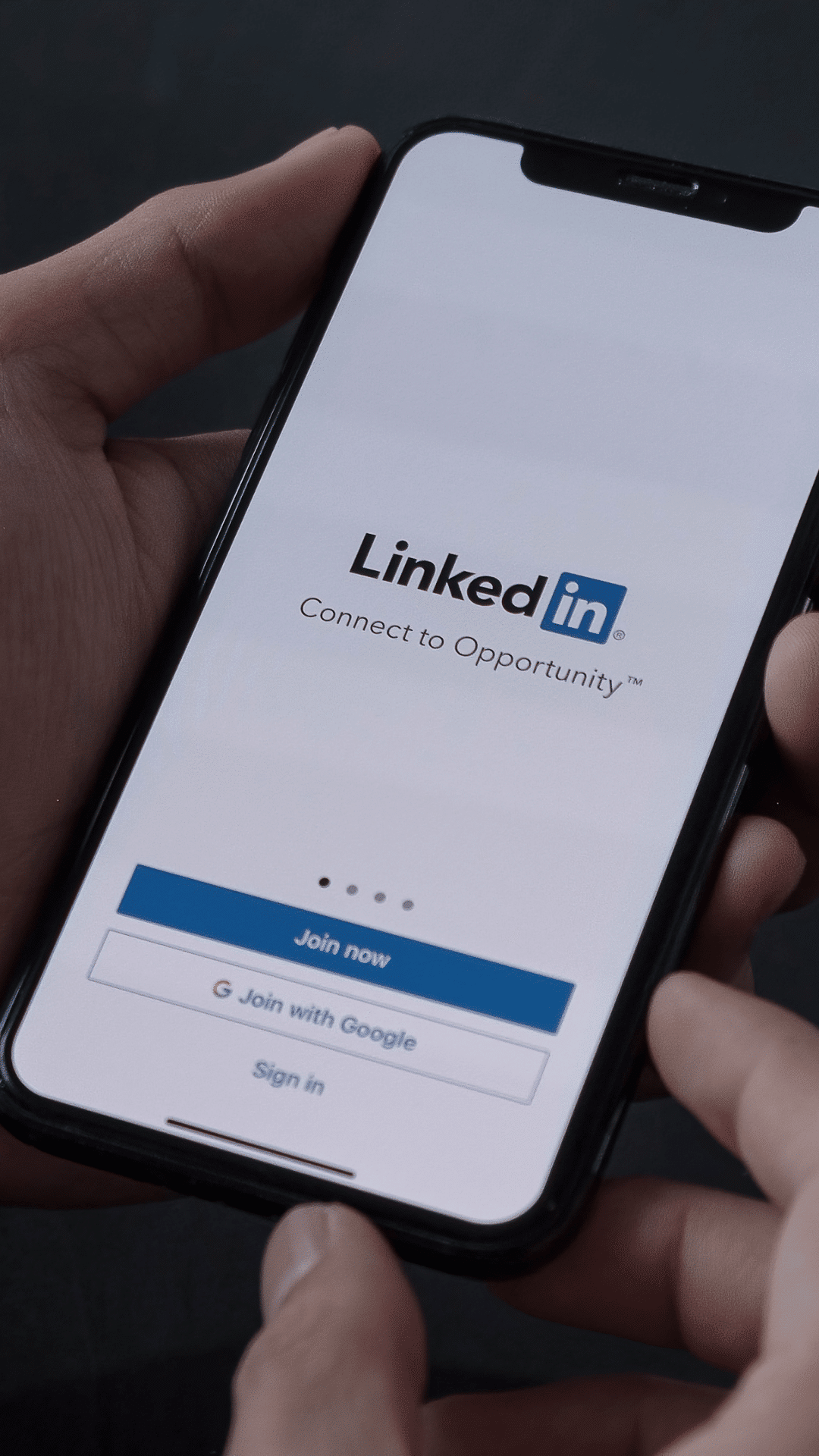
LinkedIn publishes posts that originate with the Publisher tool to LinkedIn Pulse, linked with the homepage feed. It is up to users to publish as independent authors (not behind a company name). You and your staff can use Publisher to create a long-form piece (usually 5-7 paragraphs) and share it with your audience for a more “organic” reach. So, while outside schedulers may provide you with data on the optimum times to post in a timely way as well as scheduling capabilities, posting within LinkedIn’s Publisher tool will provide you with more reach for the time being.
Hopefully, these pointers will assist you in making the most of LinkedIn Connections in 2022 and provide you with some LinkedIn Consumer insights. Leave a comment to let me know if you have any questions, and I would be more than happy to assist.
LinkedIn Prioritises displaying your content from users with whom you have already interacted and who frequently post.
So, for starters, the LinkedIn algorithm emphasises showing you information from persons with whom you have previously engaged, as well as those who post the most frequently. So, how can you make use of this?
Using LinkedIn at least 5 times per week – in posting or engaging with your LinkedIn connections. Reach is awarded to accounts with frequent interactions and engagement, as with most social media algorithms.
You should upload your own content at least five times every week, which does not have to be Monday through Friday. It could also happen on weekends. We see some content work exceptionally well, such as on Sunday nights when people go and plan for the week ahead, but you should be posting to LinkedIn at least five times each week. I understand that this may appear to be highly overwhelming.
That is why it is critical to have a social media scheduling tool as part of your LinkedIn marketing strategy, such as Buffer social scheduling tool, to go in and pre-schedule these posts so that you can fulfil the algorithm’s five times a week requirement.
As part of my LinkedIn Marketing Strategy – I realise LinkedIn displays more content from users who have a lot of engagement, even if you don’t usually like or comment on their posts.
Some social media algorithms, like YouTube, consider how much you engage with that type of material.
The algorithm’s second most essential aspect is that it will present the most or more content from those with the most significant engagement, correct? Even if you don’t usually agree with or comment on those people’s ideas. So, let’s suppose we have Anthony here, and he usually gets 20 or more comments on his posts. So, even if I’m not one of the individuals commenting on his posts, I will see them more frequently on my stream. Because, after all, what does LinkedIn want? They want us to spend as much time on LinkedIn to show us more advertising and generate more cash.
So, what can you do to influence this aspect of the algorithm? First, adhere to what I call the 80/20 rule. So, for every post you make, which you should do five times a week, you should remark on five other people’s postings.
So you write something on Monday, and then you remark on five other people’s postings. And if you can make comments before your article goes live, your work will have a greater likelihood of being seen by more people.
By going and remark on Michaela’s post, she’ll be more inclined to comment on it herself when she sees what I’ve posted pop up. Reciprocation.
LinkedIn prefers native material (text posts, photos with text, videos with text — anything that does not LINK OUT – that is, anything that takes your LinkedIn Connections OFF LinkedIn)
Okay. LinkedIn prioritised native content over content with links. This is what I mean by “native content.” You don’t need to leave LinkedIn to obtain the rest of it. So, if you have a video, you can post it natively to LinkedIn by going into your desktop, selecting the video file, and uploading it rather than linking out to YouTube. Why is this the case?
LinkedIn, as previously said, wishes to keep you on their platform for as long as possible. This is because they can show you more adverts and earn more money. As a result, they aim to keep individuals there for as long as possible. As a result, the more native content you can share, the better.
Every third or fourth post, only share posts that link OUT. Otherwise, maintaining a native content strategy LinkedIn.
What I mean is that every third or fourth post can be a link outpost. The other should be a native speaker. So, let’s pretend you did make a fantastic video. Go ahead and do it naturally. Then, the next day, you may deliver a quick quote or anything uplifting.
Maybe you’ll have a visual or infographic to offer on the third day. Then, on the + fourth day, you link back to your blog or website. So, once again, if you want to play the system, every single post should not be a link outpost.
LinkedIn is a social network that cannot be ignored, whether you create your own brand or market on behalf of a business. Longer comments are prefered over a high volume of reactions.
Okay, fine. The third position. The algorithm also prefers lengthy comments over a significant volume of reactions or merely brief comments. So, as I always say, comments are currency in social media.
Obtaining as MANY comments on your posts as QUICKLY as possible when they are posted by your LinkedIn connections is liquid gold.
The more comments you receive from your LinkedIn connections, the better and faster they become. So, when your post goes up at noon, if you receive five comments in the first 15 minutes, the algorithm begins to say, “Wow, this is fantastic stuff.” It’s in a relationship. So many people in the community have something to say, and they intend to continue expressing it to more people. So it’s going to get viral faster.
So it’s critical to understand that getting a thumbs up isn’t enough from your LinkedIn Connections. So, what kinds of posts will elicit comments? Naturally, you want to construct your material in such a way that it invites readers to leave a remark in the first place.
So, here are some ideas: ask a question at the end of your post, right?
To engage people, write something and say something like, which of you do you most agree with, A-B-C, or D so that people have to make a remark below to sort of answer along with your article. So the more comments you receive and the faster you receive them, the better.

LinkedIn Marketing that is proactive. How I take advantage of LinkedIn’s strength, you can market your home company in the following ways:
Regular status updates should be posted. Write about your current project and who you’re working for. Include updates that are relevant to your target customers and clients. Consider how you may assist others in achieving their goals.
Participate in group activities. Join LinkedIn groups that are relevant to your home business and interests. Participating in discussions might help you position yourself as an authority in your subject. Don’t spam or talk about yourself all the time. Instead, respond to questions and serve as a resource that people can rely on. It is always another way to grow LinkedIn connections.
Connect with people in your network as well as other members of your group. For example, connect with professionals who share your interests or assist you in your home business journey by sending customised messages.
Consider LinkedIn advertising. Paid advertising on LinkedIn is one alternative for swiftly putting your Personal Brand or Business in front of potential customers.
Upgrade your LinkedIn membership to a premium one. There are numerous tiers to choose from, each of which can unlock extra contact possibilities and other benefits that may be a good fit for what you’re trying to do with your home business. In addition, LinkedIn provides a free trial of their paid features, so you may try them out before making a commitment.
Do you have your facts straight about some of the bizarre LinkedIn statistics that support the notion that the social media platform will continue to dominate?
Take part in a new era of competition. Get ahead of the game. Survive the purge by adapting to change. Learn about emerging markets. Respond to the evolving needs Results that are immediate and dependable Insights that assist you in succeeding More information means more alternatives. Win pitches and please customers The most recent data stories and insights
Over two million posts, videos, and articles are now sorted, ranked, and shown in the feeds of LinkedIn’s 645 million+ members. The paid social media traffic is crucial for many organisations and brands, but organic traffic is the Holy Grail: it’s free, promotes community, and fosters loyalty.
From around 3 million users betting on the 9 billion impressions each month to the conclusion that even LinkedIn statistics back Zuckerberg’s claim that video is the next megatrend, there’s evident that there’s a lot to learn about who is using the platform why.
These statistics and experiments were personally used to improve my LinkedIn marketing strategy ( Facebook, Instagram, TikTok). As a result, it has evolved into a social network behemoth that cannot be ignored.
Use the same strategies you use on your blog and other social media platforms, but tweak them slightly for your LinkedIn connections, i.e. the Consumer needs: Your tone may need to be a little more formal than it is on Twitter, but don’t overdo it (it is a social network after all)
Do you have any interesting LinkedIn statistics to share? Put them in the comments section!
Get updated with the latest news about our company’s achievements and activities

Lash Serums That Work and are my favourite – A Review We may get paid a commission if you buy something after clicking on one of our affiliate links here

Rodan and Fields Consultant + Rodan and Fields Find a Consultant Should I join the Rodan Fields Consultant Program? EVERYTHING YOU NEED TO KNOW ABOUT BECOMING A CONSULTANT FOR RODAN

The best sunscreens The Best Sunscreens – so you can be sure you’re getting the best protection possible. AAW Your ultimate guide to the Best sunscreens CHICHI KAWA – Summer

My best hair care products We may get paid a commission if you buy something after clicking on one of our affiliate links here on the site on the best
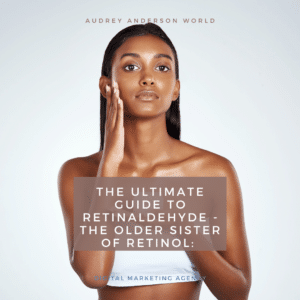
Retinaldehyde The Ultimate Guide to Retinaldehyde – the Older Sister of Retinol: The type of retinoid you use matters if you are looking for a retinoid to treat acne, premature
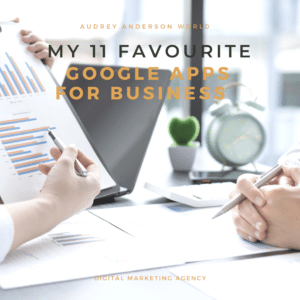
My 11 Favorite Google Apps For Business If you haven’t already, I invite you to check out the G Suite platform for your business and my Favourite Google Apps For
